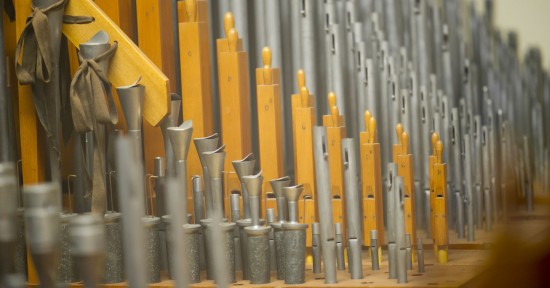Icons Among Us: The John R. Silber Symphonic Organ
BU’s mammoth musical jewel in the GSU features early 1900s computer
Watch BU’s 7,500-pipe symphonic organ fill the Metcalf Ballroom with waves of sound. Photos by Kalman Zabarsky
There aren’t too many musical instruments large enough to walk through.
But make your way to the Metcalf Ballroom, on the second floor of the George Sherman Union, take the interior stairs, hang a left, jog up a couple of more steps, and you’ll be strolling through a veritable symphonic park, small forests of silver pipes behind sections of glass. Even silent, the John R. Silber Symphonic Organ is a stunning sight.
Just wait until you hear it.
In all, the instrument is 30 feet high, 100 feet wide, boasts 7,500 pipes, and weighs a whopping 22.5 tons. It consists of five lower glassed-in chambers set along a parquet promenade and three upper ones with unenclosed ranks, or sets of pipes—skylines of wood and steel high above the carpeted ballroom. Across from the glass chambers is an operations room, home to several consoles, each with enough keys, levers, and pedals to give an octopus trouble. An adjacent room contains a compact blowing plant packed with six enormous vintage turbines kicking out 33 horsepowers of pneumatic force.
Restoration
Nelson Barden sprays a paper towel with glass cleaner and wipes down the ivory keys of a Skinner console. Some dust had drifted down from the air-conditioning duct. In the organ world, Barden (below) is famous for his restoration work on organs at the Groton School in Groton, Mass., at Boston’s Church of the Advent and Old South Church, and his just-finished eight-year rehabilitation of the largest residence organ in the world at Longwood Gardens near Philadelphia, Pa. But it was his extensive restoration, and fusion, of two residence organs donated to the University that put his name on the lips of enthusiasts around the globe.

For 12 years during the 1980s and early ’90s, Nelson Barden & Associates were BU’s restorers-in-residence, working in a specially designed studio in the Fuller Building at 808 Comm Ave. Spread before his team were bits and chunks of two player organs (instruments that play automatically without organists). The first was a water-damaged 12-rank 1930 Skinner, Opus 764, originally installed in the home of Percy Rockefeller in Greenwich, Conn., donated by John Robinson, then secretary of BU’s Board of Trustees, in 1981. Not long after, Board chairman Arthur G. B. Metcalf (SED’35, Hon.’74) donated a 23-rank 1930 Aeolian, Opus 1783 organ from his Winchester home, which had been built for a previous owner, Boston candymaker William Schrafft.
“Wealthy people had pipe organs in their homes as a status symbol and for musical entertainment,” Barden says. “They were incredibly costly items. And most of the people who bought them were not organists and so they had to be operated by paper rolls. What they wanted to do was imitate a symphony orchestra. That’s the description of these instruments. They sounded like a miniature symphony orchestra playing in your living room.”
Symphony enthusiast Metcalf had a vision: restore both instruments and combine them into a larger musical entity that could regularly fill the GSU ballroom (which would later be named after him) with the sounds of cymbals, cellos, violins, harps, chimes, xylophones, flutes, tubas—the list goes on.
A computer before computers
One element—a giant wooden panel of wires, ducts, jacks, leather, and lights—that accompanied the donated water-stained Skinner organ puzzled Barden. It came with a patent, dated July 25, 1916, but it showed only the wiring layout, not how it operated. Many of the wires had been chewed up by rats. “That’s the player relay,” an old Skinner worker told Barden. “It was a secret project.” After months of contemplation and tinkering and trial and error, Barden got the thing to cough up some sound. From there, he was able to connect the actions of the machine to the pipes of the organ. The player relay allowed the instrument to produce more notes than a traditional punched paper roll. Barden realized that for the past year he’d had his fingers in the guts of a binary computer patented eight years before IBM was formed and decades before keyboards and monitors were even concepts.
“The instrument is important because of what it was originally, which was a computer—a minimalist computer that was operated by 12 volts DC, just like a car today, and air pressure,” Barden says. “And the combination of those two things produced a mechanism which actually could do rudimentary computer functions. The memory storage was punched paper rolls. As the roll unfurled, the mechanism took that information and translated it into the impulses that drove the pipe organ.”
During the project, additions from other vintage Skinner and Aeolian organs swelled the instrument from 35 to 62 ranks. Thousands of visitors descended on Barden’s Comm Ave studio to study and gawk at the restored instrument. Barden and his staff gave hundreds of demos, and during the 1990 American Guild of Organists National Convention, held in Boston, the organ’s late-night performances were a conference highlight. Barden and the BU organ ended up the subject of an episode of PBS’s Restoration Stories.

The room was never built.In 1993, the restored and fused symphonic organ, now operated by a modern-day computer that had translated the musical information on the paper rolls into digital form, was relocated to the Metcalf Ballroom and dedicated in honor of John Silber (Hon.’95), BU’s seventh president. A third black console was added and was intended to live in a display room at the top of the stairs, where it could easily be wheeled out for public performances.
Interest wanes
Metcalf had envisioned the organ playing every day at lunchtime, among other things, but after he retired in 1994, funding fell off and interest in the unusual instrument dropped. Except among the few. For his course The Electric Guitar as Gateway to Electro Acoustics, Robert Kotiuga (above, right), a College of Engineering associate professor, brings his students to the ballroom’s second floor as a field trip. He has even proposed a course based solely on the various facets of the organ.
“Unfortunately, the renovation of the symphonic organ did not come with a plan for integrating it into the life of the University,” Kotiuga says. “Except for events such as graduations and Halloween, where it is used to accompany silent movie versions of The Phantom of the Opera, it has become an underutilized resource, and a missed opportunity. It’s a marvelous snapshot in the development of modern technology and a fantastic primary source for understanding the social implications of evolving technology.”

Triumphant sounds
Although Barden wrapped up the project years ago, the organ restorer is clearly still attached to his gargantuan beauty. He twists the paper towel and buffs the ivory stops on the console until they shine, then heads into the blower room. When he throws the switch, it sounds like jet engines and the room feels like it might lift off. Barden steps over to the computer, fires up the monitor, punches in some DOS commands, hits enter, and George Cobb’s “Russian Rag” starts pouring through the building.
It isn’t long before curious passersby step into the ballroom with cell-phone cameras, filming the massive wooden shutters in the upper wall opening and closing, unleashing waves of music into the air. Behind the glass chamber doors, myriad pipes open and close while felted hammers strike strings. The huge carpeted room is enveloped as if in a dust storm.
“There are very few 1920s symphonic residence organs that are still left in playable condition,” Barden says. “As far as I know, only four are completely restored with this particular mechanism to drive them. Possible future uses should certainly entail bringing classes to see this thing in operation. Right here in BU you’ve got a working 1916 computer. This really should be in the history of things here.”
Caleb Daniloff can be reached at cdanilof@bu.edu. Nicolae Ciorogan can be reached at ciorogan@bu.edu.
Read about more icons here.
Comments & Discussion
Boston University moderates comments to facilitate an informed, substantive, civil conversation. Abusive, profane, self-promotional, misleading, incoherent or off-topic comments will be rejected. Moderators are staffed during regular business hours (EST) and can only accept comments written in English. Statistics or facts must include a citation or a link to the citation.